University Finance Case 2: Options Analysis and Hedging Strategies
VerifiedAdded on 2022/08/26
|11
|1591
|31
Case Study
AI Summary
This finance case study examines Aunt Betty's investment portfolio and the use of options to mitigate risk. The analysis covers call and put options, their pricing, and how they can be used to hedge against potential losses in Suncor shares. The case study explores the impact of strike prices, current stock prices, and time to expiration on option values. Additionally, it delves into the use of futures contracts for hedging crude oil price exposure, analyzing contract details and potential hedging strategies for Canuck Oil Corporation. The document provides detailed calculations and explanations to support the analysis, offering insights into portfolio management and risk mitigation techniques. The case covers topics such as call and put options, intrinsic value, and the relationship between call value and time to expiration and risk-free rate. Finally, it evaluates the effectiveness of different hedging strategies and provides recommendations for Aunt Betty and Canuck Oil Corporation.
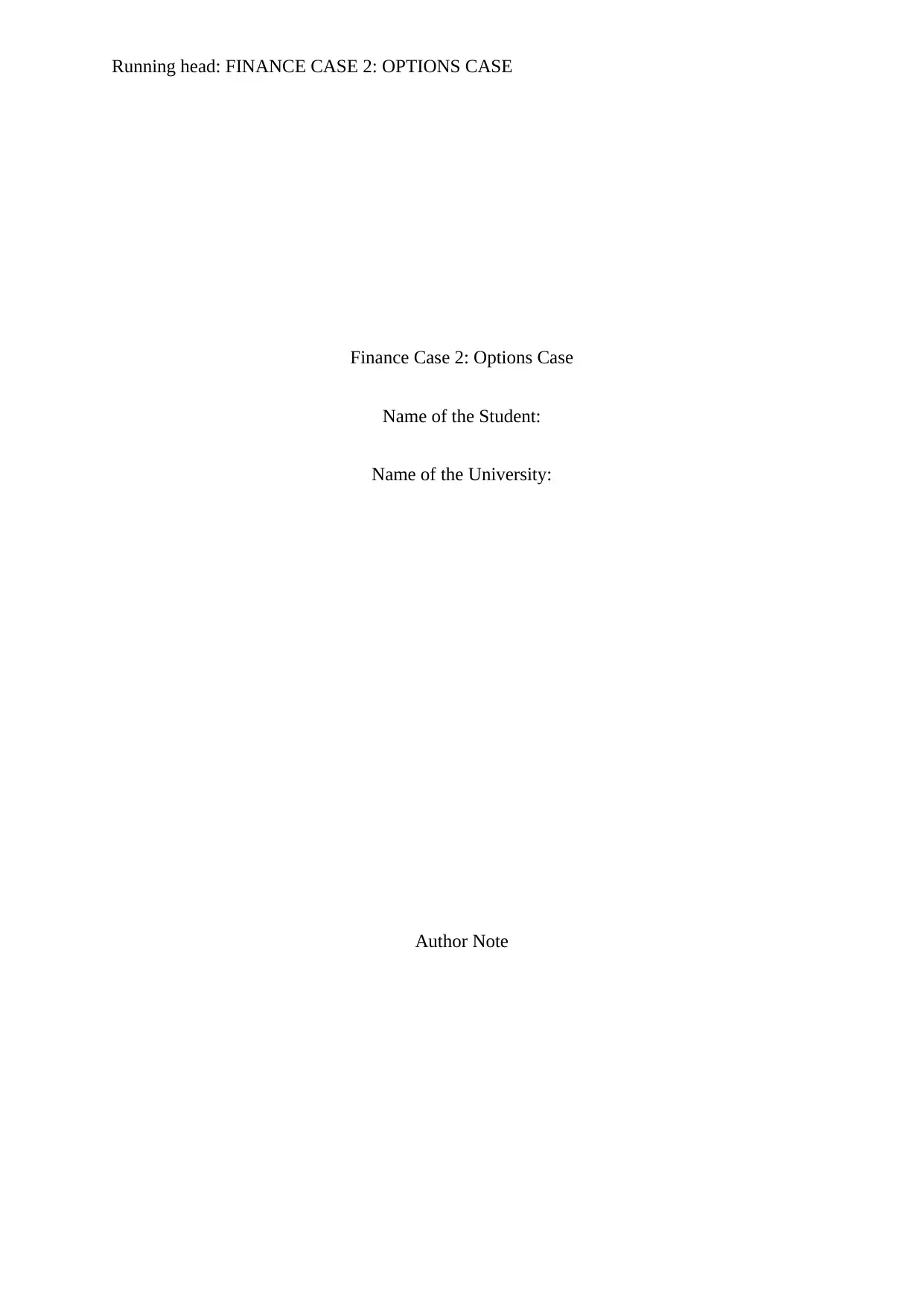
Running head: FINANCE CASE 2: OPTIONS CASE
Finance Case 2: Options Case
Name of the Student:
Name of the University:
Author Note
Finance Case 2: Options Case
Name of the Student:
Name of the University:
Author Note
Paraphrase This Document
Need a fresh take? Get an instant paraphrase of this document with our AI Paraphraser
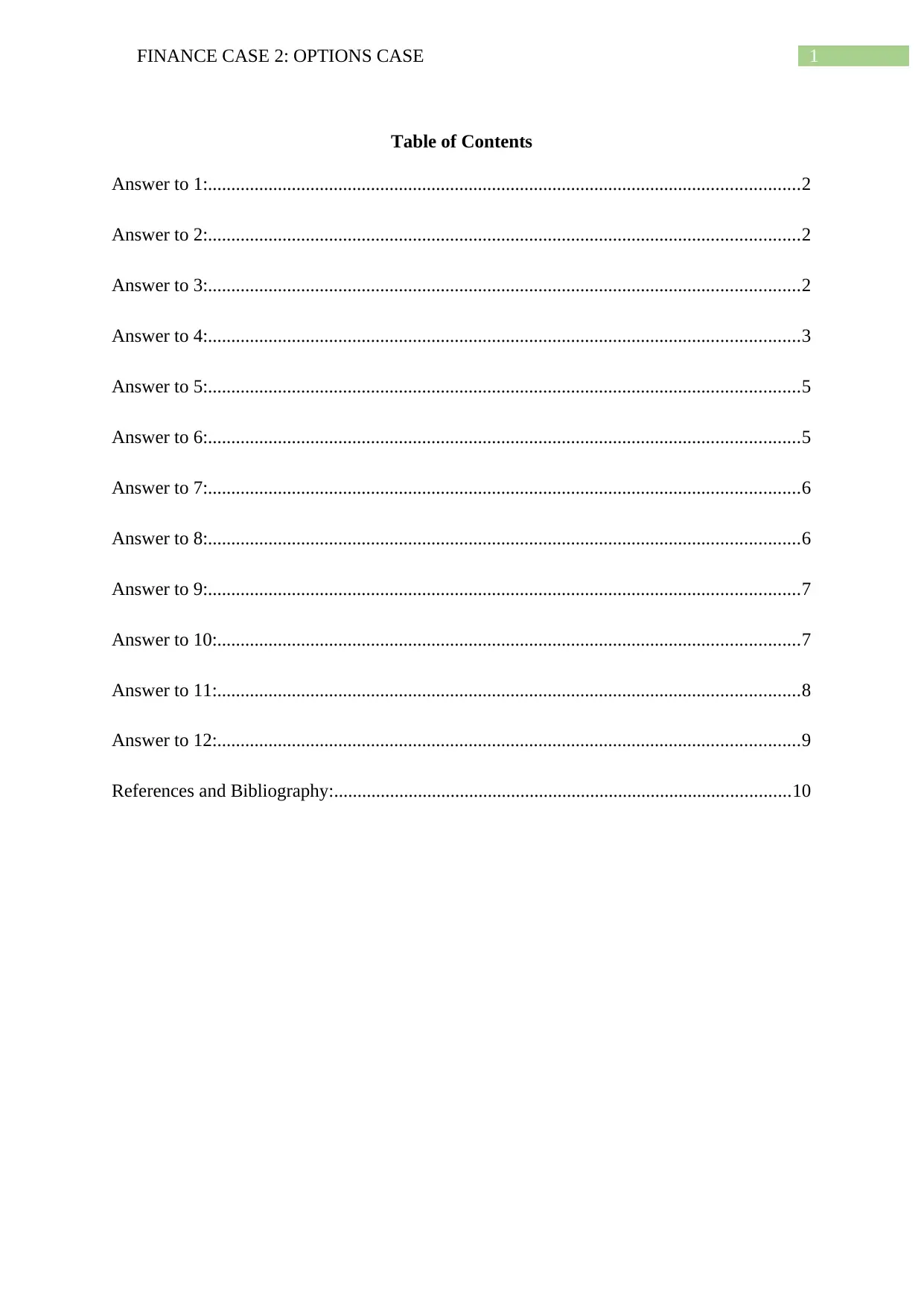
1FINANCE CASE 2: OPTIONS CASE
Table of Contents
Answer to 1:...............................................................................................................................2
Answer to 2:...............................................................................................................................2
Answer to 3:...............................................................................................................................2
Answer to 4:...............................................................................................................................3
Answer to 5:...............................................................................................................................5
Answer to 6:...............................................................................................................................5
Answer to 7:...............................................................................................................................6
Answer to 8:...............................................................................................................................6
Answer to 9:...............................................................................................................................7
Answer to 10:.............................................................................................................................7
Answer to 11:.............................................................................................................................8
Answer to 12:.............................................................................................................................9
References and Bibliography:..................................................................................................10
Table of Contents
Answer to 1:...............................................................................................................................2
Answer to 2:...............................................................................................................................2
Answer to 3:...............................................................................................................................2
Answer to 4:...............................................................................................................................3
Answer to 5:...............................................................................................................................5
Answer to 6:...............................................................................................................................5
Answer to 7:...............................................................................................................................6
Answer to 8:...............................................................................................................................6
Answer to 9:...............................................................................................................................7
Answer to 10:.............................................................................................................................7
Answer to 11:.............................................................................................................................8
Answer to 12:.............................................................................................................................9
References and Bibliography:..................................................................................................10
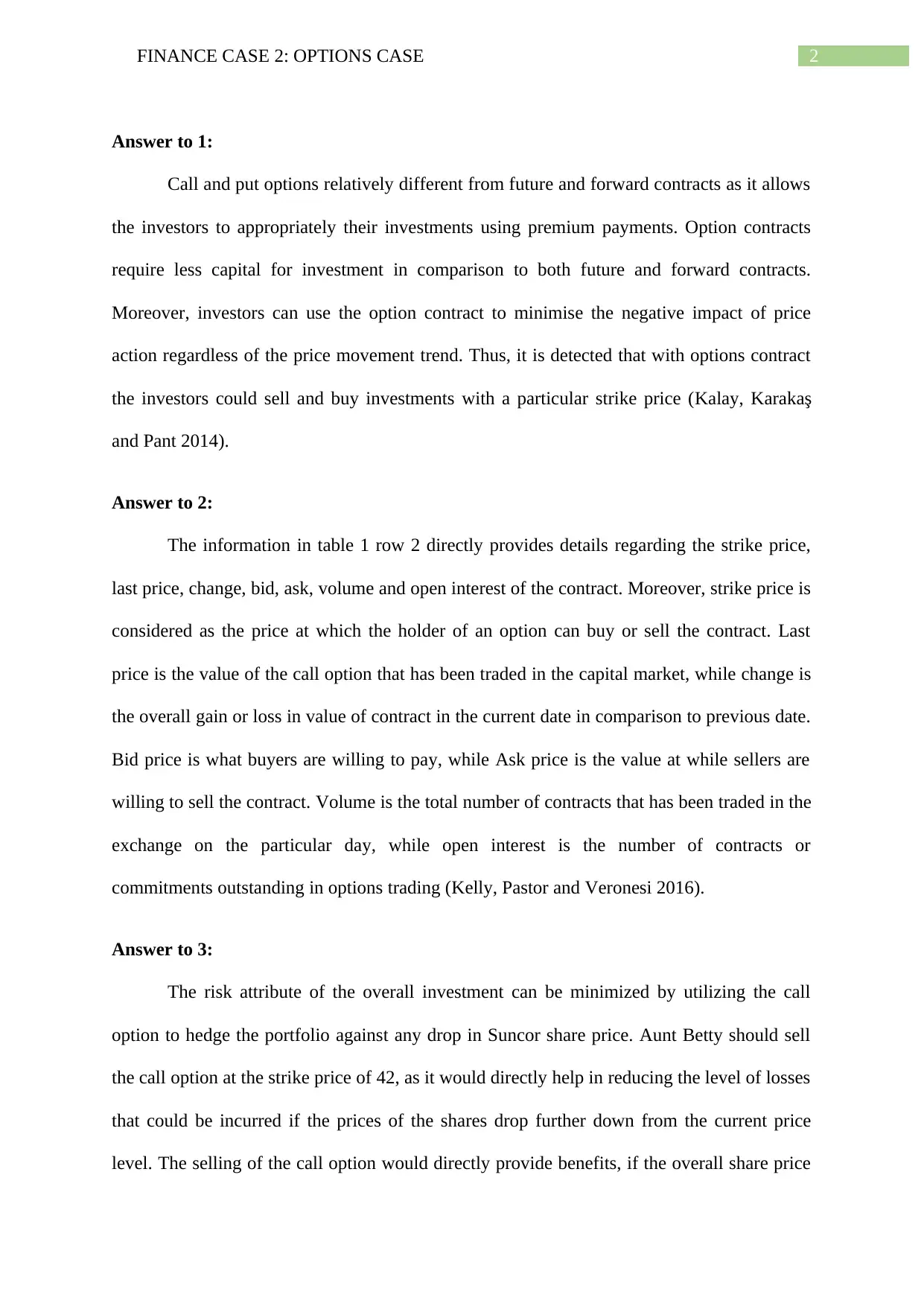
2FINANCE CASE 2: OPTIONS CASE
Answer to 1:
Call and put options relatively different from future and forward contracts as it allows
the investors to appropriately their investments using premium payments. Option contracts
require less capital for investment in comparison to both future and forward contracts.
Moreover, investors can use the option contract to minimise the negative impact of price
action regardless of the price movement trend. Thus, it is detected that with options contract
the investors could sell and buy investments with a particular strike price (Kalay, Karakaş
and Pant 2014).
Answer to 2:
The information in table 1 row 2 directly provides details regarding the strike price,
last price, change, bid, ask, volume and open interest of the contract. Moreover, strike price is
considered as the price at which the holder of an option can buy or sell the contract. Last
price is the value of the call option that has been traded in the capital market, while change is
the overall gain or loss in value of contract in the current date in comparison to previous date.
Bid price is what buyers are willing to pay, while Ask price is the value at while sellers are
willing to sell the contract. Volume is the total number of contracts that has been traded in the
exchange on the particular day, while open interest is the number of contracts or
commitments outstanding in options trading (Kelly, Pastor and Veronesi 2016).
Answer to 3:
The risk attribute of the overall investment can be minimized by utilizing the call
option to hedge the portfolio against any drop in Suncor share price. Aunt Betty should sell
the call option at the strike price of 42, as it would directly help in reducing the level of losses
that could be incurred if the prices of the shares drop further down from the current price
level. The selling of the call option would directly provide benefits, if the overall share price
Answer to 1:
Call and put options relatively different from future and forward contracts as it allows
the investors to appropriately their investments using premium payments. Option contracts
require less capital for investment in comparison to both future and forward contracts.
Moreover, investors can use the option contract to minimise the negative impact of price
action regardless of the price movement trend. Thus, it is detected that with options contract
the investors could sell and buy investments with a particular strike price (Kalay, Karakaş
and Pant 2014).
Answer to 2:
The information in table 1 row 2 directly provides details regarding the strike price,
last price, change, bid, ask, volume and open interest of the contract. Moreover, strike price is
considered as the price at which the holder of an option can buy or sell the contract. Last
price is the value of the call option that has been traded in the capital market, while change is
the overall gain or loss in value of contract in the current date in comparison to previous date.
Bid price is what buyers are willing to pay, while Ask price is the value at while sellers are
willing to sell the contract. Volume is the total number of contracts that has been traded in the
exchange on the particular day, while open interest is the number of contracts or
commitments outstanding in options trading (Kelly, Pastor and Veronesi 2016).
Answer to 3:
The risk attribute of the overall investment can be minimized by utilizing the call
option to hedge the portfolio against any drop in Suncor share price. Aunt Betty should sell
the call option at the strike price of 42, as it would directly help in reducing the level of losses
that could be incurred if the prices of the shares drop further down from the current price
level. The selling of the call option would directly provide benefits, if the overall share price
⊘ This is a preview!⊘
Do you want full access?
Subscribe today to unlock all pages.

Trusted by 1+ million students worldwide
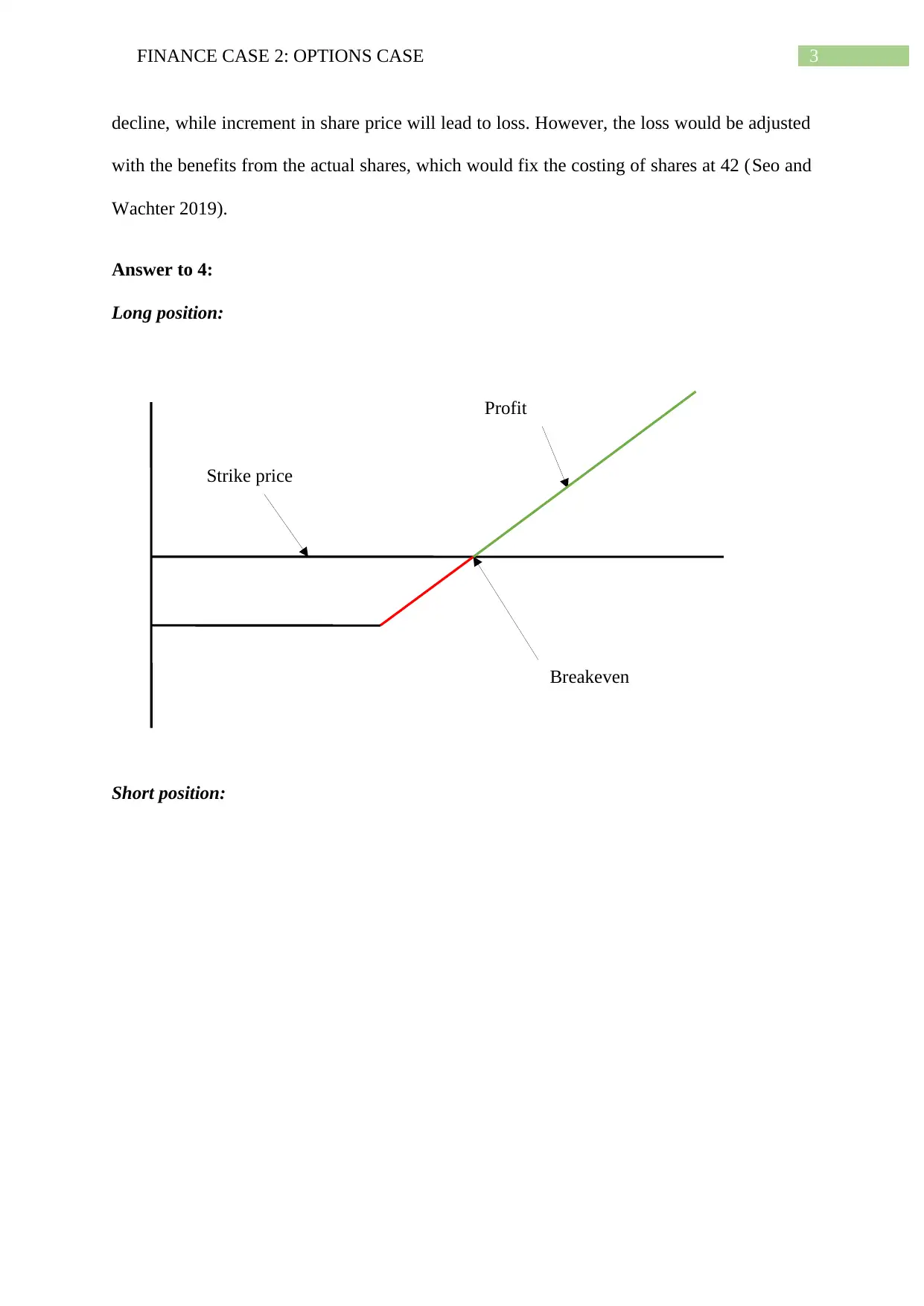
3FINANCE CASE 2: OPTIONS CASE
Strike price
Breakeven
Profit
decline, while increment in share price will lead to loss. However, the loss would be adjusted
with the benefits from the actual shares, which would fix the costing of shares at 42 (Seo and
Wachter 2019).
Answer to 4:
Long position:
Short position:
Strike price
Breakeven
Profit
decline, while increment in share price will lead to loss. However, the loss would be adjusted
with the benefits from the actual shares, which would fix the costing of shares at 42 (Seo and
Wachter 2019).
Answer to 4:
Long position:
Short position:
Paraphrase This Document
Need a fresh take? Get an instant paraphrase of this document with our AI Paraphraser
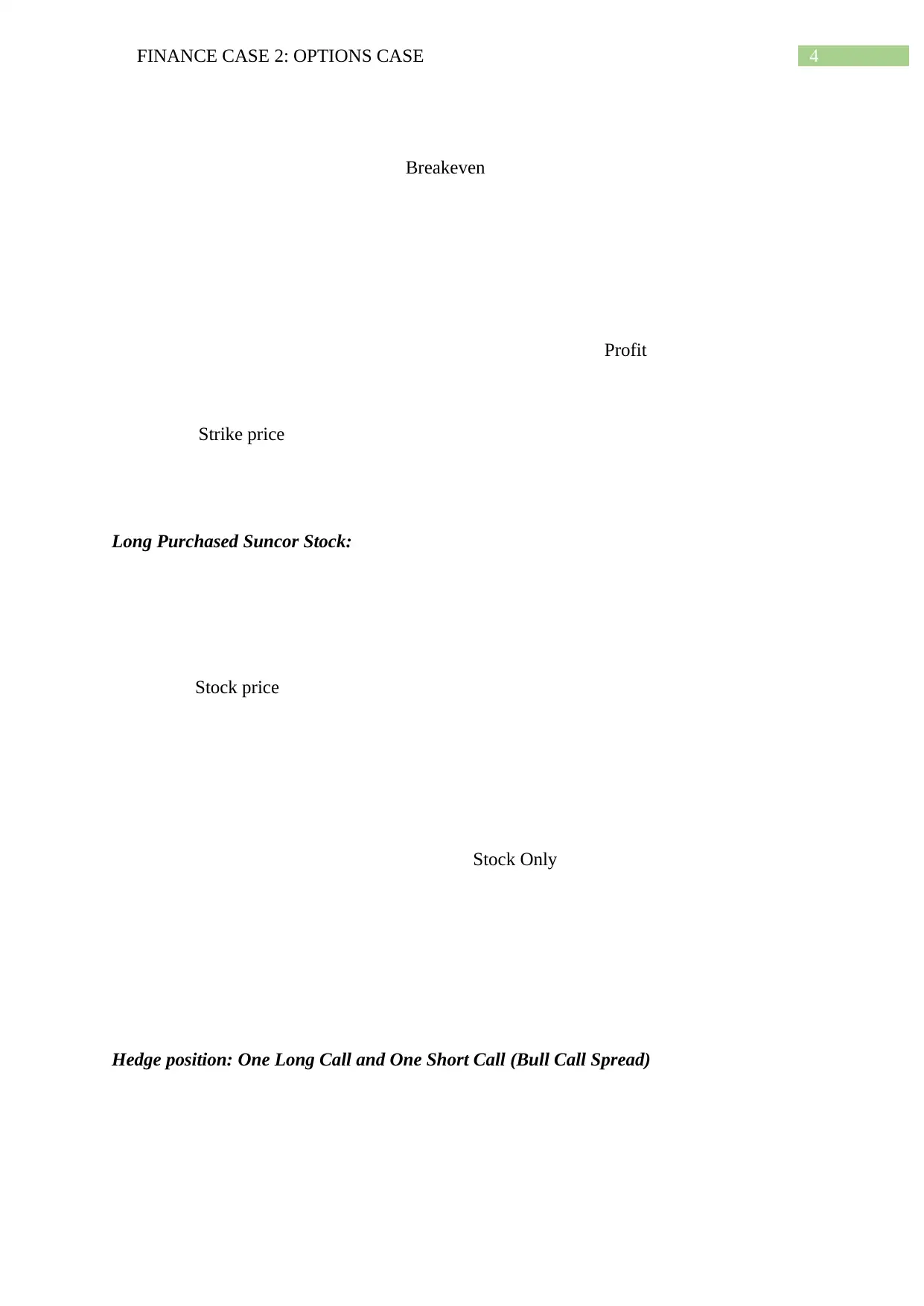
4FINANCE CASE 2: OPTIONS CASE
Strike price
Breakeven
Profit
Stock price
Stock Only
Long Purchased Suncor Stock:
Hedge position: One Long Call and One Short Call (Bull Call Spread)
Strike price
Breakeven
Profit
Stock price
Stock Only
Long Purchased Suncor Stock:
Hedge position: One Long Call and One Short Call (Bull Call Spread)
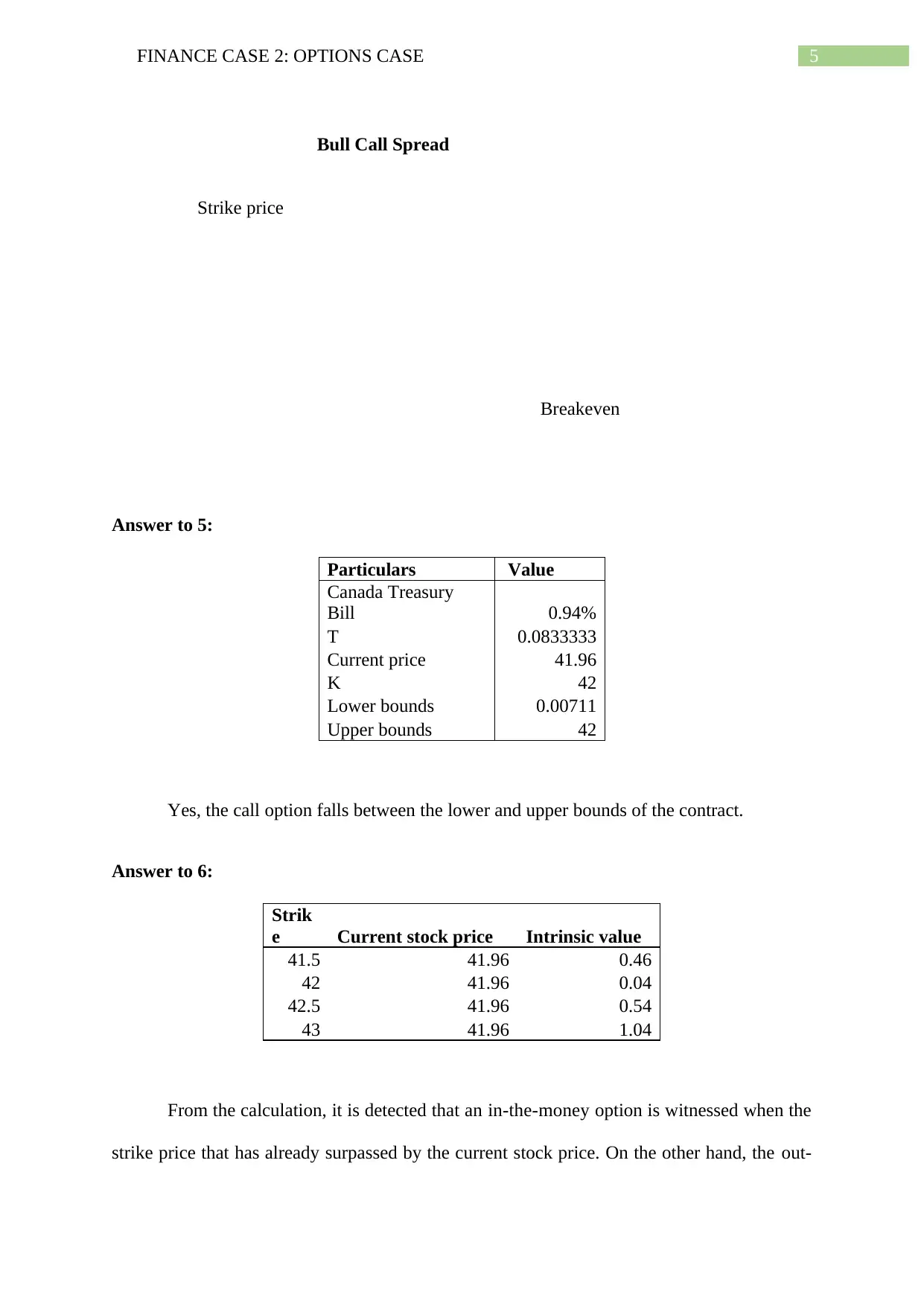
5FINANCE CASE 2: OPTIONS CASE
Strike price
Breakeven
Bull Call Spread
Answer to 5:
Particulars Value
Canada Treasury
Bill 0.94%
T 0.0833333
Current price 41.96
K 42
Lower bounds 0.00711
Upper bounds 42
Yes, the call option falls between the lower and upper bounds of the contract.
Answer to 6:
Strik
e Current stock price Intrinsic value
41.5 41.96 0.46
42 41.96 0.04
42.5 41.96 0.54
43 41.96 1.04
From the calculation, it is detected that an in-the-money option is witnessed when the
strike price that has already surpassed by the current stock price. On the other hand, the out-
Strike price
Breakeven
Bull Call Spread
Answer to 5:
Particulars Value
Canada Treasury
Bill 0.94%
T 0.0833333
Current price 41.96
K 42
Lower bounds 0.00711
Upper bounds 42
Yes, the call option falls between the lower and upper bounds of the contract.
Answer to 6:
Strik
e Current stock price Intrinsic value
41.5 41.96 0.46
42 41.96 0.04
42.5 41.96 0.54
43 41.96 1.04
From the calculation, it is detected that an in-the-money option is witnessed when the
strike price that has already surpassed by the current stock price. On the other hand, the out-
⊘ This is a preview!⊘
Do you want full access?
Subscribe today to unlock all pages.

Trusted by 1+ million students worldwide
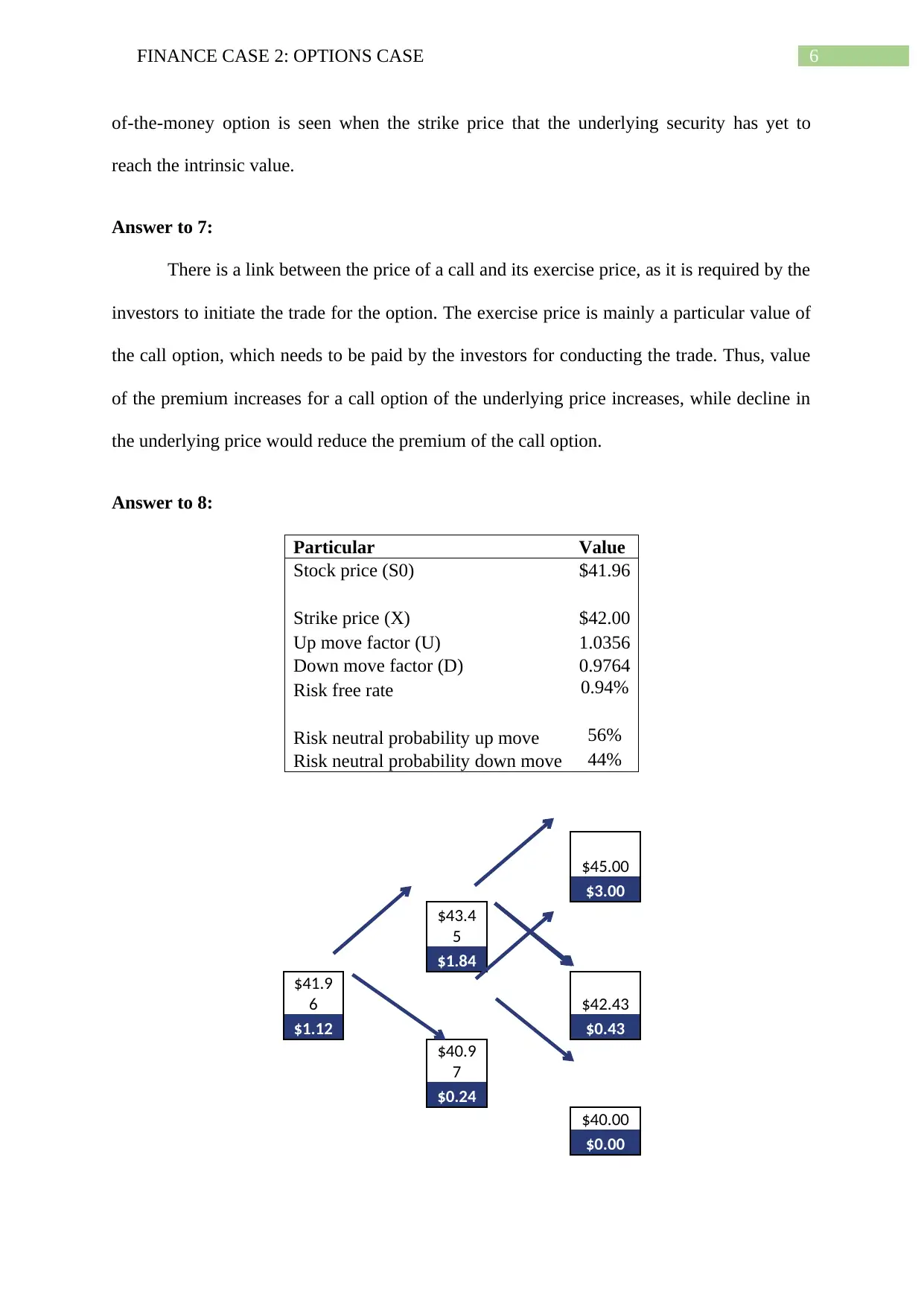
6FINANCE CASE 2: OPTIONS CASE
of-the-money option is seen when the strike price that the underlying security has yet to
reach the intrinsic value.
Answer to 7:
There is a link between the price of a call and its exercise price, as it is required by the
investors to initiate the trade for the option. The exercise price is mainly a particular value of
the call option, which needs to be paid by the investors for conducting the trade. Thus, value
of the premium increases for a call option of the underlying price increases, while decline in
the underlying price would reduce the premium of the call option.
Answer to 8:
Particular Value
Stock price (S0) $41.96
Strike price (X) $42.00
Up move factor (U) 1.0356
Down move factor (D) 0.9764
Risk free rate 0.94%
Risk neutral probability up move 56%
Risk neutral probability down move 44%
$45.00
$3.00
$43.4
5
$1.84
$41.9
6 $42.43
$1.12 $0.43
$40.9
7
$0.24
$40.00
$0.00
of-the-money option is seen when the strike price that the underlying security has yet to
reach the intrinsic value.
Answer to 7:
There is a link between the price of a call and its exercise price, as it is required by the
investors to initiate the trade for the option. The exercise price is mainly a particular value of
the call option, which needs to be paid by the investors for conducting the trade. Thus, value
of the premium increases for a call option of the underlying price increases, while decline in
the underlying price would reduce the premium of the call option.
Answer to 8:
Particular Value
Stock price (S0) $41.96
Strike price (X) $42.00
Up move factor (U) 1.0356
Down move factor (D) 0.9764
Risk free rate 0.94%
Risk neutral probability up move 56%
Risk neutral probability down move 44%
$45.00
$3.00
$43.4
5
$1.84
$41.9
6 $42.43
$1.12 $0.43
$40.9
7
$0.24
$40.00
$0.00
Paraphrase This Document
Need a fresh take? Get an instant paraphrase of this document with our AI Paraphraser
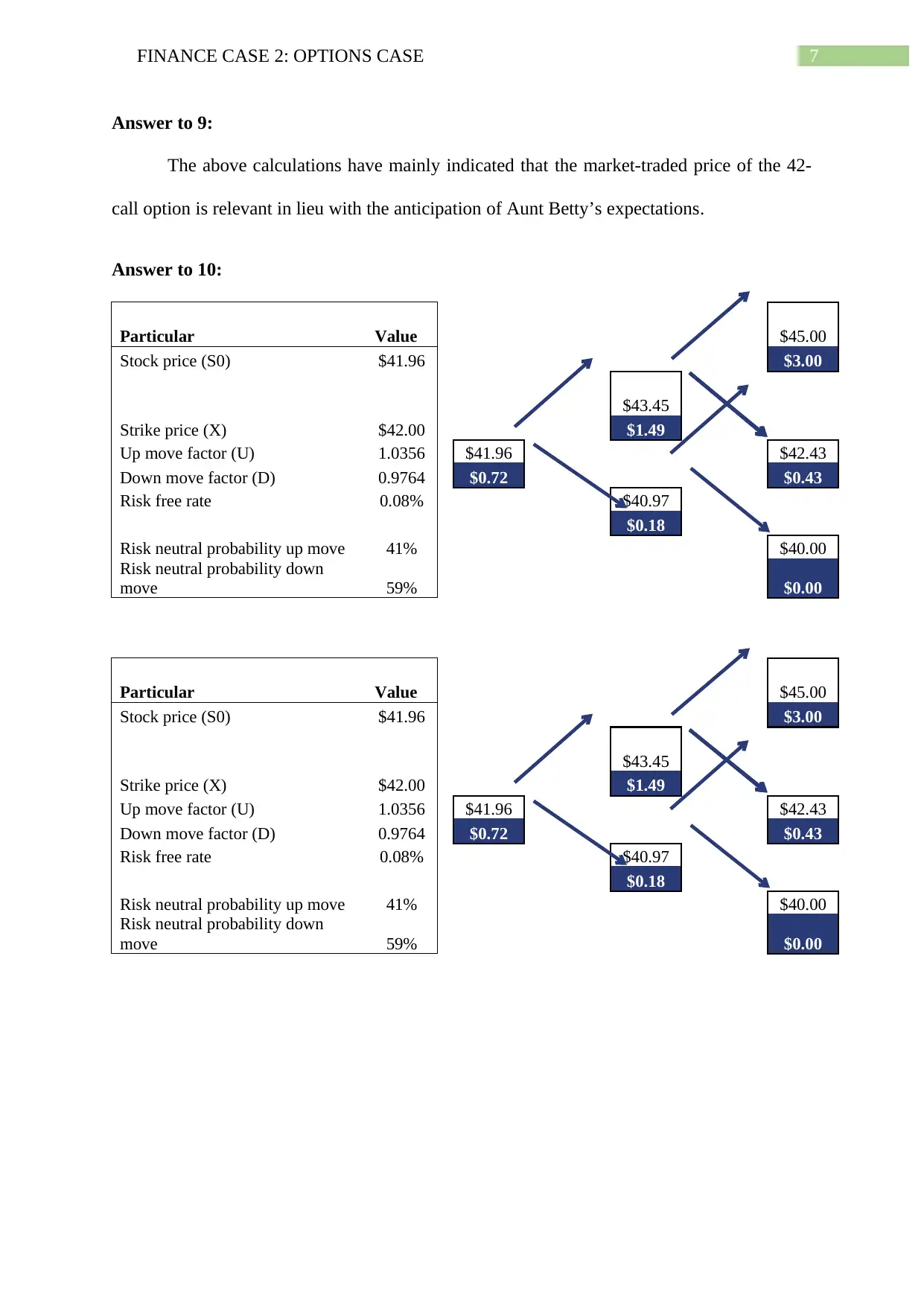
7FINANCE CASE 2: OPTIONS CASE
Answer to 9:
The above calculations have mainly indicated that the market-traded price of the 42-
call option is relevant in lieu with the anticipation of Aunt Betty’s expectations.
Answer to 10:
Particular Value $45.00
Stock price (S0) $41.96 $3.00
$43.45
Strike price (X) $42.00 $1.49
Up move factor (U) 1.0356 $41.96 $42.43
Down move factor (D) 0.9764 $0.72 $0.43
Risk free rate 0.08% $40.97
$0.18
Risk neutral probability up move 41% $40.00
Risk neutral probability down
move 59% $0.00
Particular Value $45.00
Stock price (S0) $41.96 $3.00
$43.45
Strike price (X) $42.00 $1.49
Up move factor (U) 1.0356 $41.96 $42.43
Down move factor (D) 0.9764 $0.72 $0.43
Risk free rate 0.08% $40.97
$0.18
Risk neutral probability up move 41% $40.00
Risk neutral probability down
move 59% $0.00
Answer to 9:
The above calculations have mainly indicated that the market-traded price of the 42-
call option is relevant in lieu with the anticipation of Aunt Betty’s expectations.
Answer to 10:
Particular Value $45.00
Stock price (S0) $41.96 $3.00
$43.45
Strike price (X) $42.00 $1.49
Up move factor (U) 1.0356 $41.96 $42.43
Down move factor (D) 0.9764 $0.72 $0.43
Risk free rate 0.08% $40.97
$0.18
Risk neutral probability up move 41% $40.00
Risk neutral probability down
move 59% $0.00
Particular Value $45.00
Stock price (S0) $41.96 $3.00
$43.45
Strike price (X) $42.00 $1.49
Up move factor (U) 1.0356 $41.96 $42.43
Down move factor (D) 0.9764 $0.72 $0.43
Risk free rate 0.08% $40.97
$0.18
Risk neutral probability up move 41% $40.00
Risk neutral probability down
move 59% $0.00
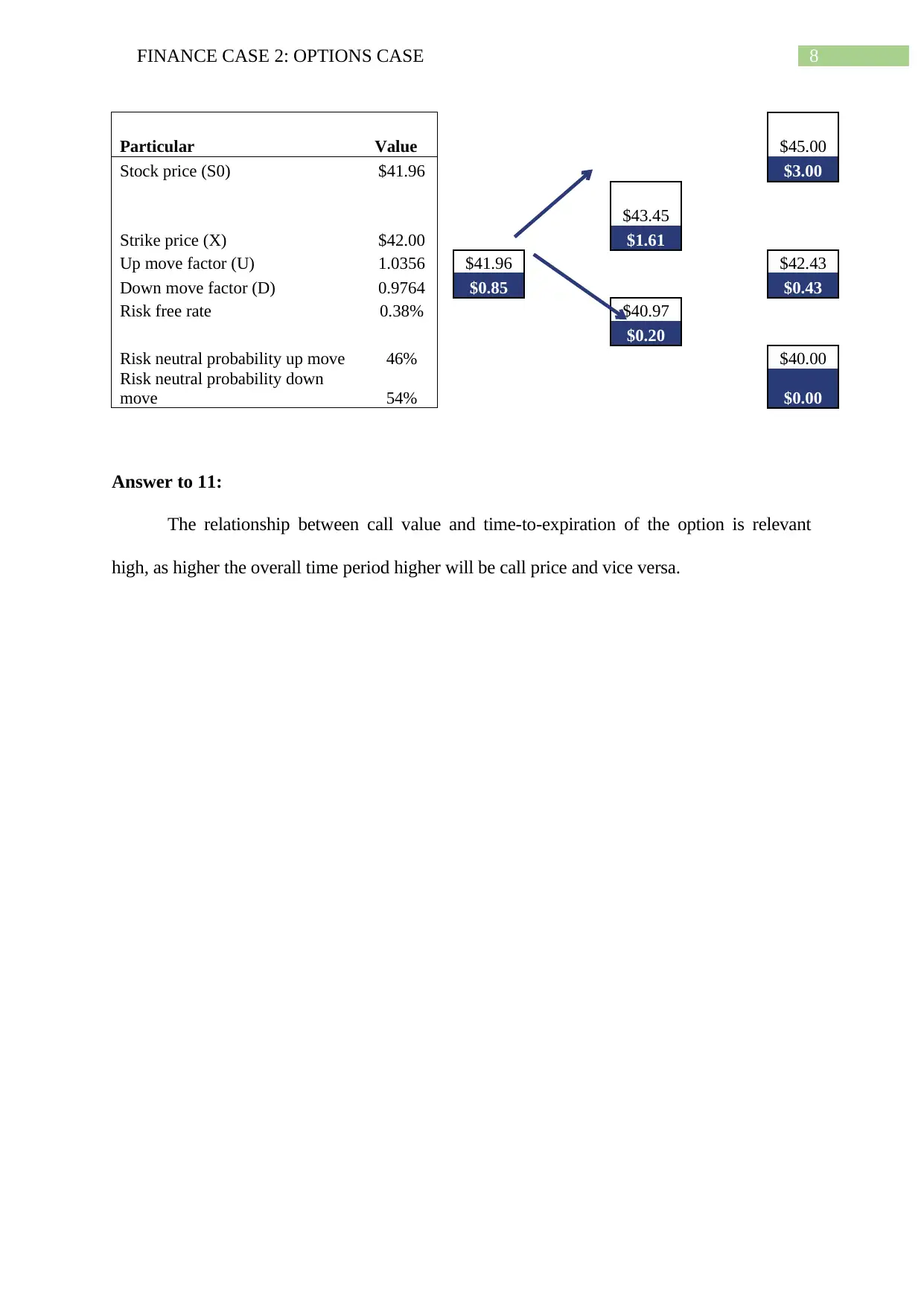
8FINANCE CASE 2: OPTIONS CASE
Particular Value $45.00
Stock price (S0) $41.96 $3.00
$43.45
Strike price (X) $42.00 $1.61
Up move factor (U) 1.0356 $41.96 $42.43
Down move factor (D) 0.9764 $0.85 $0.43
Risk free rate 0.38% $40.97
$0.20
Risk neutral probability up move 46% $40.00
Risk neutral probability down
move 54% $0.00
Answer to 11:
The relationship between call value and time-to-expiration of the option is relevant
high, as higher the overall time period higher will be call price and vice versa.
Particular Value $45.00
Stock price (S0) $41.96 $3.00
$43.45
Strike price (X) $42.00 $1.61
Up move factor (U) 1.0356 $41.96 $42.43
Down move factor (D) 0.9764 $0.85 $0.43
Risk free rate 0.38% $40.97
$0.20
Risk neutral probability up move 46% $40.00
Risk neutral probability down
move 54% $0.00
Answer to 11:
The relationship between call value and time-to-expiration of the option is relevant
high, as higher the overall time period higher will be call price and vice versa.
⊘ This is a preview!⊘
Do you want full access?
Subscribe today to unlock all pages.

Trusted by 1+ million students worldwide
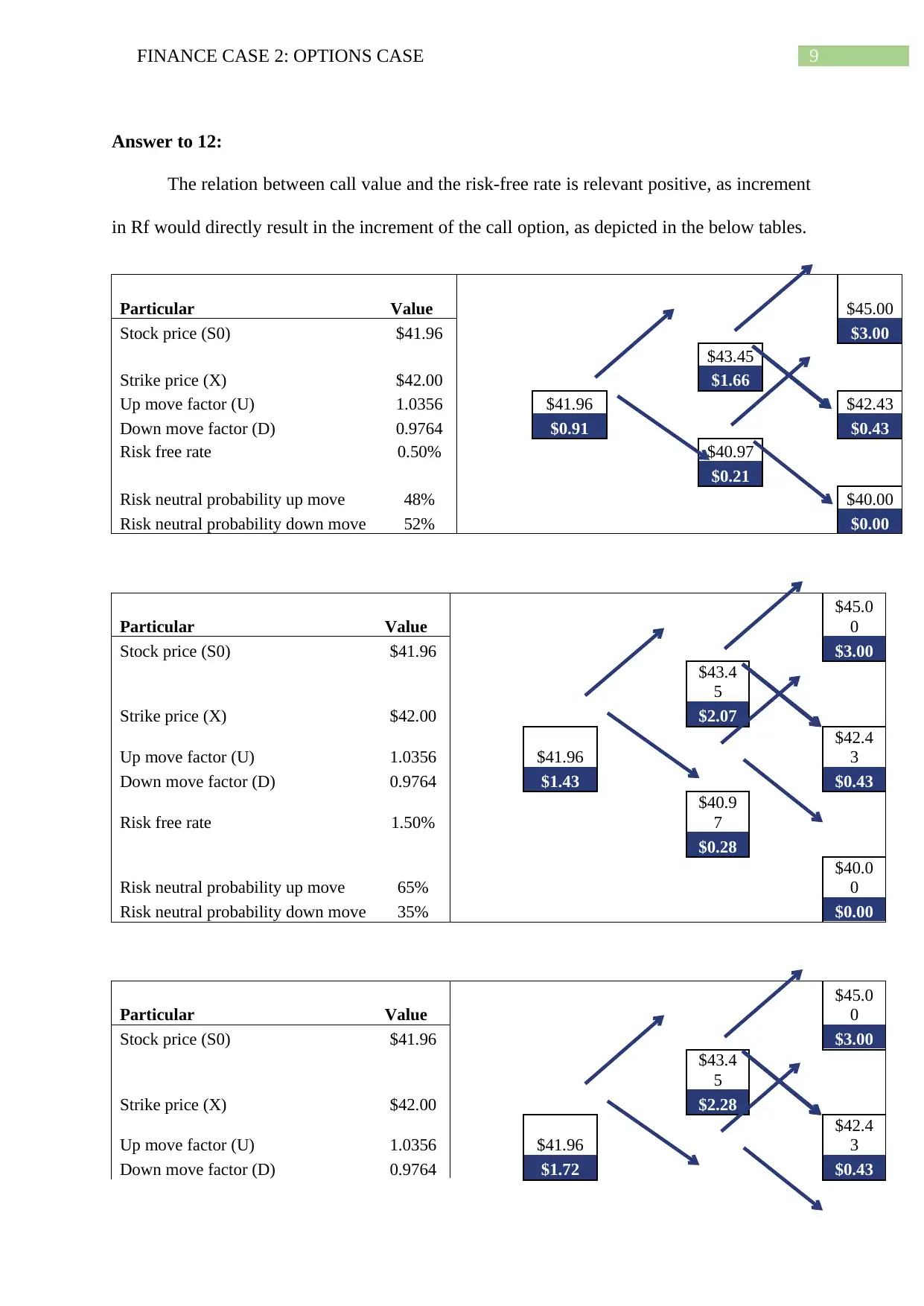
9FINANCE CASE 2: OPTIONS CASE
Answer to 12:
The relation between call value and the risk-free rate is relevant positive, as increment
in Rf would directly result in the increment of the call option, as depicted in the below tables.
Particular Value $45.00
Stock price (S0) $41.96 $3.00
$43.45
Strike price (X) $42.00 $1.66
Up move factor (U) 1.0356 $41.96 $42.43
Down move factor (D) 0.9764 $0.91 $0.43
Risk free rate 0.50% $40.97
$0.21
Risk neutral probability up move 48% $40.00
Risk neutral probability down move 52% $0.00
Particular Value
$45.0
0
Stock price (S0) $41.96 $3.00
$43.4
5
Strike price (X) $42.00 $2.07
Up move factor (U) 1.0356 $41.96
$42.4
3
Down move factor (D) 0.9764 $1.43 $0.43
Risk free rate 1.50%
$40.9
7
$0.28
Risk neutral probability up move 65%
$40.0
0
Risk neutral probability down move 35% $0.00
Particular Value
$45.0
0
Stock price (S0) $41.96 $3.00
$43.4
5
Strike price (X) $42.00 $2.28
Up move factor (U) 1.0356 $41.96
$42.4
3
Down move factor (D) 0.9764 $1.72 $0.43
Answer to 12:
The relation between call value and the risk-free rate is relevant positive, as increment
in Rf would directly result in the increment of the call option, as depicted in the below tables.
Particular Value $45.00
Stock price (S0) $41.96 $3.00
$43.45
Strike price (X) $42.00 $1.66
Up move factor (U) 1.0356 $41.96 $42.43
Down move factor (D) 0.9764 $0.91 $0.43
Risk free rate 0.50% $40.97
$0.21
Risk neutral probability up move 48% $40.00
Risk neutral probability down move 52% $0.00
Particular Value
$45.0
0
Stock price (S0) $41.96 $3.00
$43.4
5
Strike price (X) $42.00 $2.07
Up move factor (U) 1.0356 $41.96
$42.4
3
Down move factor (D) 0.9764 $1.43 $0.43
Risk free rate 1.50%
$40.9
7
$0.28
Risk neutral probability up move 65%
$40.0
0
Risk neutral probability down move 35% $0.00
Particular Value
$45.0
0
Stock price (S0) $41.96 $3.00
$43.4
5
Strike price (X) $42.00 $2.28
Up move factor (U) 1.0356 $41.96
$42.4
3
Down move factor (D) 0.9764 $1.72 $0.43
Paraphrase This Document
Need a fresh take? Get an instant paraphrase of this document with our AI Paraphraser
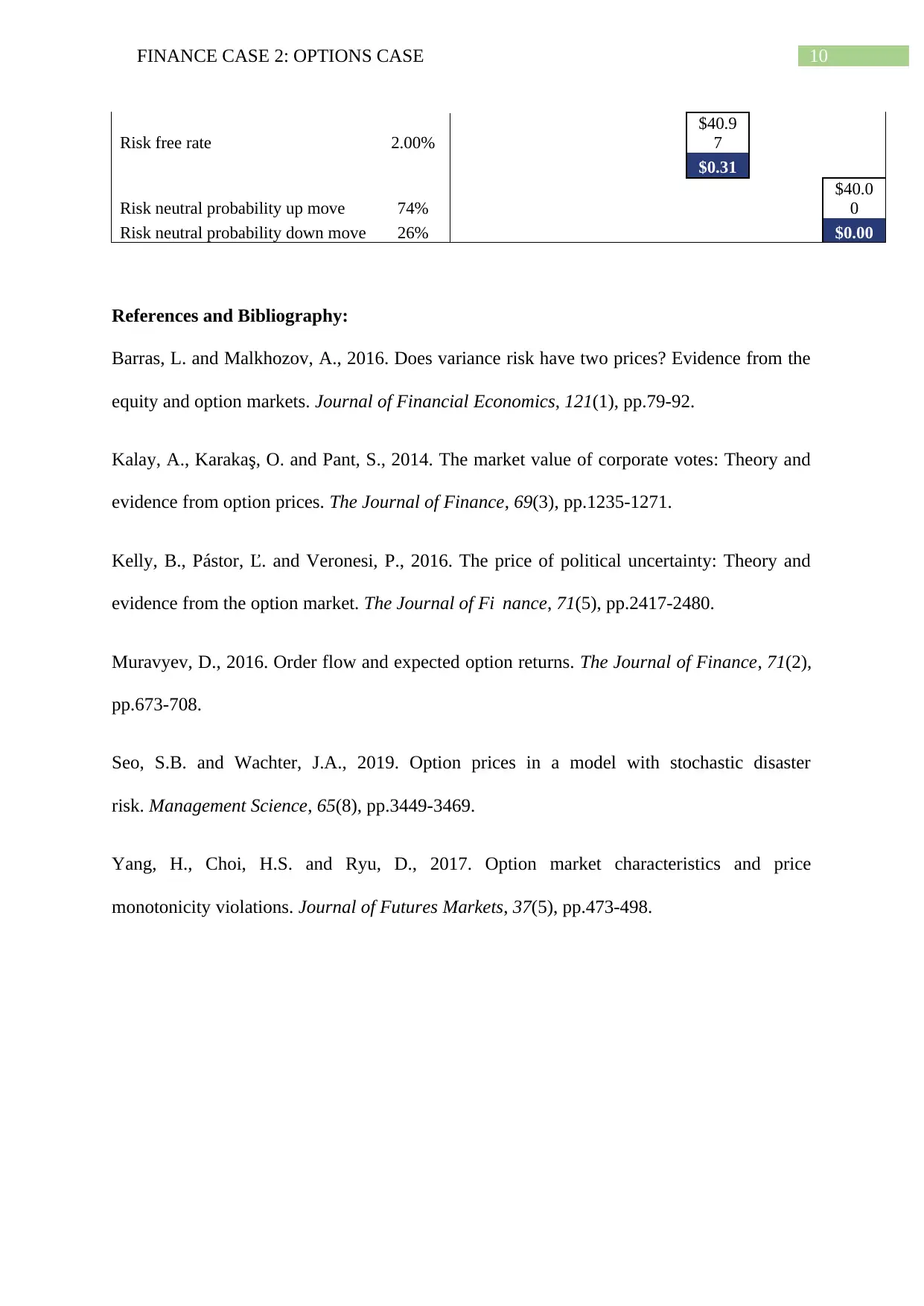
10FINANCE CASE 2: OPTIONS CASE
Risk free rate 2.00%
$40.9
7
$0.31
Risk neutral probability up move 74%
$40.0
0
Risk neutral probability down move 26% $0.00
References and Bibliography:
Barras, L. and Malkhozov, A., 2016. Does variance risk have two prices? Evidence from the
equity and option markets. Journal of Financial Economics, 121(1), pp.79-92.
Kalay, A., Karakaş, O. and Pant, S., 2014. The market value of corporate votes: Theory and
evidence from option prices. The Journal of Finance, 69(3), pp.1235-1271.
Kelly, B., Pástor, Ľ. and Veronesi, P., 2016. The price of political uncertainty: Theory and
evidence from the option market. The Journal of Fi nance, 71(5), pp.2417-2480.
Muravyev, D., 2016. Order flow and expected option returns. The Journal of Finance, 71(2),
pp.673-708.
Seo, S.B. and Wachter, J.A., 2019. Option prices in a model with stochastic disaster
risk. Management Science, 65(8), pp.3449-3469.
Yang, H., Choi, H.S. and Ryu, D., 2017. Option market characteristics and price
monotonicity violations. Journal of Futures Markets, 37(5), pp.473-498.
Risk free rate 2.00%
$40.9
7
$0.31
Risk neutral probability up move 74%
$40.0
0
Risk neutral probability down move 26% $0.00
References and Bibliography:
Barras, L. and Malkhozov, A., 2016. Does variance risk have two prices? Evidence from the
equity and option markets. Journal of Financial Economics, 121(1), pp.79-92.
Kalay, A., Karakaş, O. and Pant, S., 2014. The market value of corporate votes: Theory and
evidence from option prices. The Journal of Finance, 69(3), pp.1235-1271.
Kelly, B., Pástor, Ľ. and Veronesi, P., 2016. The price of political uncertainty: Theory and
evidence from the option market. The Journal of Fi nance, 71(5), pp.2417-2480.
Muravyev, D., 2016. Order flow and expected option returns. The Journal of Finance, 71(2),
pp.673-708.
Seo, S.B. and Wachter, J.A., 2019. Option prices in a model with stochastic disaster
risk. Management Science, 65(8), pp.3449-3469.
Yang, H., Choi, H.S. and Ryu, D., 2017. Option market characteristics and price
monotonicity violations. Journal of Futures Markets, 37(5), pp.473-498.
1 out of 11
Related Documents
Your All-in-One AI-Powered Toolkit for Academic Success.
+13062052269
info@desklib.com
Available 24*7 on WhatsApp / Email
![[object Object]](/_next/static/media/star-bottom.7253800d.svg)
Unlock your academic potential
Copyright © 2020–2025 A2Z Services. All Rights Reserved. Developed and managed by ZUCOL.





